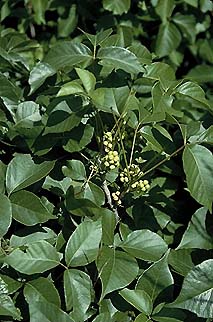Poison ivy
Rhus toxicodendron/typhina Poison ivy is a mighty liana which clings tightly to the stalks of trees in Europe, North America, West-, Middle- and East Asia. |
Poison ivy is a ten-meter-high tree. The leaves and the bark of both plants contain a very poisonous resinous substance which has an allergenic effect. A subsequent exposure to their poison is always more dangerous than a previous one. The most toxic compound is the oleoresin.
Poison ivy
sap badly damages skin after a short-lived itching. In a few hours, a rash
appears as well as reddening and swelling of parts of the body that have
been in contact with the plant. After that, itching returns accompanied
by a local sharp stinging pain. General symptoms also include fever, vomiting and diarrhea. There is a great risk of a lethal end after oral intake of parts of the plant. |
|
There are also cases of irritation and inflammation of the skin and the mucous membrane. These are caused by a long stay in gardens where poison ivy is cultivated as a decorative plant. A number of medicinal substances such as tannin and gallic acid are extracted from poison ivy. They are common ingredients of medicines used in rheumatology, dermatology and neurology.

